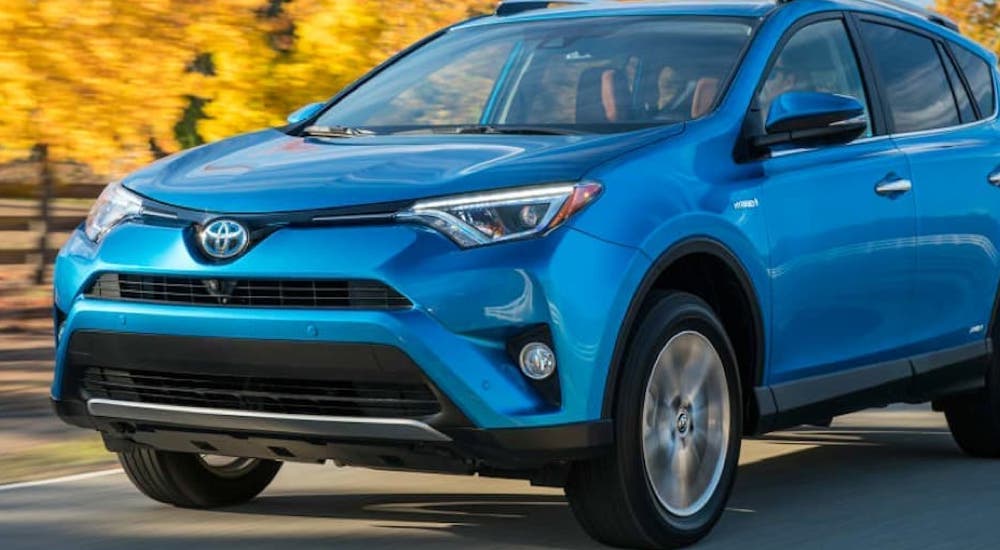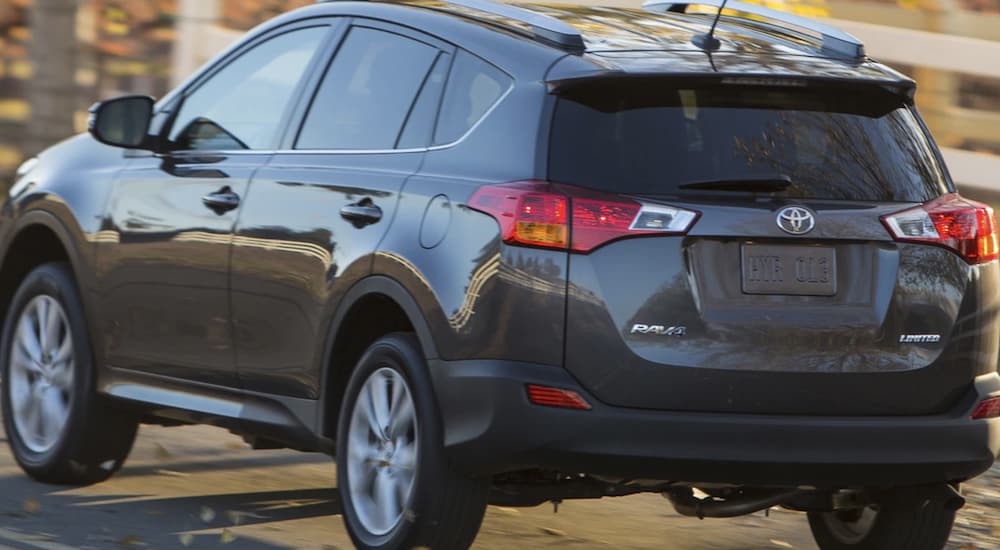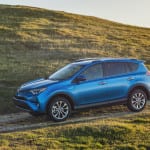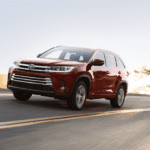If you’re looking at used SUVs for sale, you’re almost certainly going to come across the Toyota RAV4. A versatile compact crossover, the model has been around for decades, and according to the Kelley Blue Book, it was the fourth best selling vehicle in 2021. In fact, it was the #1 bestseller for cars and SUVs since the top three spots on the list went to pickup trucks. The RAV4’s popularity makes it an interesting model to look at since it can tell us a lot about automotive trends.
Like most vehicles, the RAV4 has undergone a lot of evolution, especially in recent years. Looking at the different features, trim levels, and powertrains added to this model recently gives us an interesting picture of what drivers, and SUV drivers, in particular, are looking for and how their tastes have changed over the past few years. So let’s take a look at some of the most notable innovations the RAV4 has seen over the past decade.
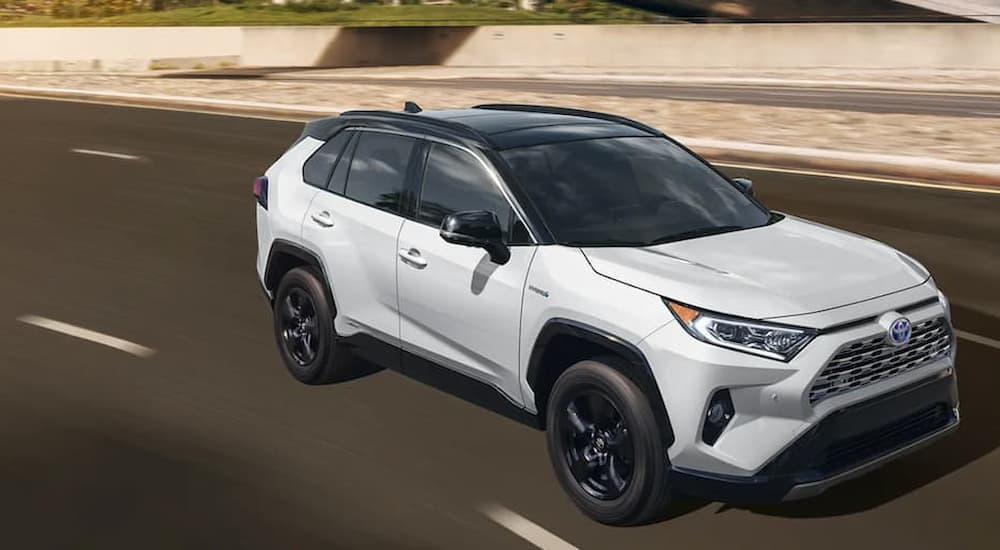
Toyota Safety Sense
Driver assistance technology is one of the biggest new trends in the automotive industry. Essentially, these are systems that are meant to improve a driver’s ability to avoid dangerous situations on the road through a combination of early warnings and automated reaction systems. Warnings include visual pop ups on the infotainment screen and audio cues that might tell the driver that a forward collision is imminent or that they are straying out of their lane. Automated systems can control the steering or braking under certain circumstances.
Toyota made its suite of driver assistance features, Toyota Safety Sense, standard across all RAV4 trims in the 2017 model year. This is fairly early compared to competitors. The Honda CR-V, Chevrolet Equinox, and Ford Escape didn’t make their driver assistance tech standard on all trim levels until the 2020 model year. So while Toyota was an early adopter, the rest of the auto industry has largely followed suit: driver assistance tech is becoming standard fare on more and more vehicles every year. Eventually, it’s possible that some of these features will become mandatory, like airbags, seatbelts, anti lock brakes, traction control, stability control, and backup cameras are today.
The Toyota Safety Sense features that were made standard on the 2017 RAV4 include:
- Pre-Collision System with Pedestrian Detection: Uses an integrated camera and radar to detect an imminent forward collision with another vehicle or a pedestrian and uses audio and visual warnings to prompt the driver to brake. If the driver fails to brake in time, the system can automatically apply the brakes to avoid or lessen the collision.
- Brake Assist: If you brake too late or too little to avoid the collision, the system can provide additional force to help you slow or stop.
- Lane Departure Alert with Steering Assist: An in-vehicle camera is used to detect the lane markers and the vehicle’s position within them. If you start to drift out of your lane unintentionally (without the turn signal on), the system provides a warning. If the driver doesn’t react to the Lane Departure Alert, the system can apply subtle corrective steering to keep the vehicle in its lane.
- Dynamic Radar Cruise Control: If the road ahead is open, then the system operates like conventional cruise control, keeping the vehicle running at a set speed. The system can use a combination of a camera and radar sensors to detect another vehicle in front of you and maintain a preset following distance, slowing down and speeding back up as necessary.
Automatic High Beam Headlights: Cameras detect headlights from oncoming traffic and taillights from cars in front of you and turn the high beams on and off as necessary to avoid distracting or blinding other drivers.
Hybrid Powertrain
Toyota’s best-known hybrid is certainly the Prius, but many of its other vehicles have been available with hybrid powertrains for years now. The RAV4 got its first hybrid version in the 2016 model year. This obviously offers improved fuel economy over the non-hybrid version (the 2016 RAV4’s gas engine has a city fuel economy rating of 23 MPG while the hybrid is rated at 34 MPG), but that isn’t its only advantage. The hybrid system uses the same base engine, a 2.5L inline-4, and simply adds an electric motor alongside it. Overall, this makes it a more powerful system, offering an extra 18 horsepower and 34 lb-ft of torque compared to the non-hybrid powertrain. In practical terms, the 2016 RAV4 Hybrid can tow 1,750 lbs, compared to the 1,500 lbs that the gas-powered version can handle.
This is a factor that many other automakers have used as a selling point for their SUV and truck hybrids in recent years. Instead of solely leaning on the angle of environmentalism or saving money on fuel, brands have been creating powerful hybrids and touting their stats. This has opened up the hybrid market to new demographics, including many people who were previously disinterested in, or even openly hostile to, eco-friendly options.
For the 2021 model year, the RAV4 introduced a plug-in hybrid version, the RAV4 Prime, supplementing the gas engine with a pair of electric motors and a large lithium-ion battery. The 2021 RAV4 Prime gets 94 MPGe (38 MPG combined). And, unlike the traditional hybrid, the PHEV can be used in electric vehicle mode, running entirely off of electrical power and not using the gas engine at all. In this mode, the 2021 RAV4 Hybrid can travel for an estimated 42 miles without using any gas.
Off-Road Trims
In the past five years, the RAV4 has introduced two new trim levels that make it more tough and rugged. The first came in 2018. The Adventure trim has extra ground clearance compared to the base model, along with standard all-wheel drive, a 120-volt outlet that can be used to power camping gear, and exclusive 18-inch wheels. The trim also offers an available Cold Weather package, with heated seats, a heated steering wheel, and front windshield wiper de-icers.
For the 2020 model year, the RAV4’s off-road capability was taken up a notch with the TRD trim. Like the Adventure, the TRD offers additional ground clearance, standard all-wheel drive, and a 120V outlet in the cargo area. On top of that, it has a specially-tuned MacPherson strut front suspension with a stabilizer bar and a multi-link rear suspension with a stabilizer bar. This gives it more off-road capability with a smoother ride on uneven surfaces. It also features a power moonroof as a standard feature, offering more of a view during outdoor excursions in scenic areas.
Plenty of popular compact crossovers, like the Honda CR-V, Chevy Equinox, and Ford Escape, don’t currently offer a dedicated off-road trim. Instead, they focus entirely on providing comfort on paved roads, leaving other models (like the Ford Bronco Sport, for instance) to cover the demographic of thrill seekers. On the other hand, companies like Jeep and Subaru offer rugged capability across all trim levels. It will be interesting to see whether or not the middle ground Toyota is offering with the RAV4 catches on in the compact SUV segment in the years to come.
There’s No Question as to Why the RAV4 Is a Popular Choice
By the numbers, it’s clear that the RAV4 is a popular vehicle among American drivers. The automotive market is complicated, so it’s hard to pin down an exact reason why, but the fact that the RAV4 has been an early adopter of several trends that have gone on to become ubiquitous is probably a big factor. Toyota seems to have done a good job keeping its finger on the pulse of American drivers with the RAV4, and we’ll be interested to see how this model continues to evolve in the future.
